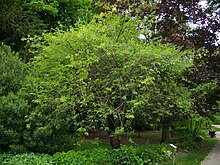Prunus serrula
| Prunus serrula | |
|---|---|

| |
| Growth form | |
| Scientific classification | |
| Kingdom: | Plantae |
| Clade: | Tracheophytes |
| Clade: | Angiosperms |
| Clade: | Eudicots |
| Clade: | Rosids |
| Order: | Rosales |
| Family: | Rosaceae |
| Genus: | Prunus |
| Section: | P. sect. Cerasus |
| Species: | P. serrula
|
| Binomial name | |
| Prunus serrula | |
| Synonyms[1] | |
| |
Prunus serrula, called birch bark cherry, birchbark cherry, paperbark cherry, or Tibetan cherry, is a species of cherry native to China, and is used as an ornamental in many parts of the world for its striking coppery-red bark.
Description
[edit]
Prunus serrula is a small deciduous tree, often with multiple stems, reaching a height of 20–30 feet (6–9 m). The leaves are arranged alternately, simple, 5–10 cm long and 1.5–2.0 cm broad and a serrate margin.[2] The smooth bark is a brownish red, with prominent horizontal lenticels. The outer layer of the bark is remarkably tough, approaching the strength of Mylar.[3]
Flowers
[edit]The flowers, typical of Prunus, are produced in clusters of one to three. The fruit is a small oval bright red drupe.[4]
Cultivation
[edit]
Prunus serrula is grown as an ornamental tree, especially for winter interest. It tolerates a variety of soil types and has a wide pH range. It prefers full sun and does well in USDA hardiness zones 5 to 8. Its potential as an invasive species is low, as it is susceptible to many common garden diseases and pests such as fire blight, powdery mildew and Japanese beetles.[citation needed]
It is sometimes grafted to Prunus serrulata (Japanese cherry) crowns, forming a tree with red bark and showier flowers.
In 2012 the 'Branklyn' variety gained the Royal Horticultural Society's Award of Garden Merit.[5]
References
[edit]- ^ The Plant List: A Working List of All Plant Species, retrieved 7 June 2018
- ^ "Prunus serrula". Landscape Plants. Oregon State University. Retrieved 7 June 2018.
- ^ Xu, Xiaoming; Schneider, Edward; Chien, Allen T.; Wudl, Fred (16 September 1997). "Nature's High-Strength Semitransparent Film: The Remarkable Mechanical Properties of Prunus serrula Bark". Chemistry of Materials. 9 (9): 1906–1908. doi:10.1021/cm9701522.
- ^ "Prunus serrula | Tibetan cherry/RHS Gardening".
- ^ "Prunus serrula 'Branklyn'". Royal Horticultural Society. 2017. Retrieved 28 June 2018.
